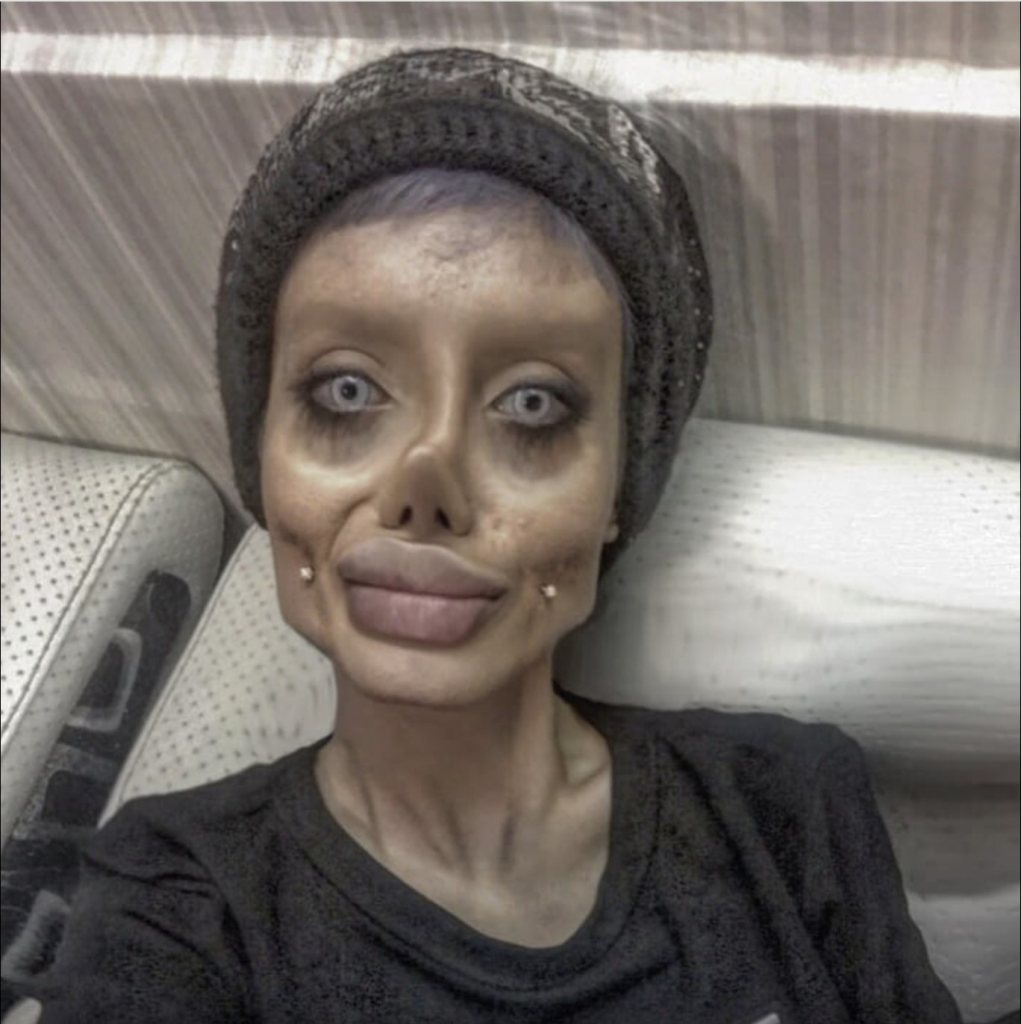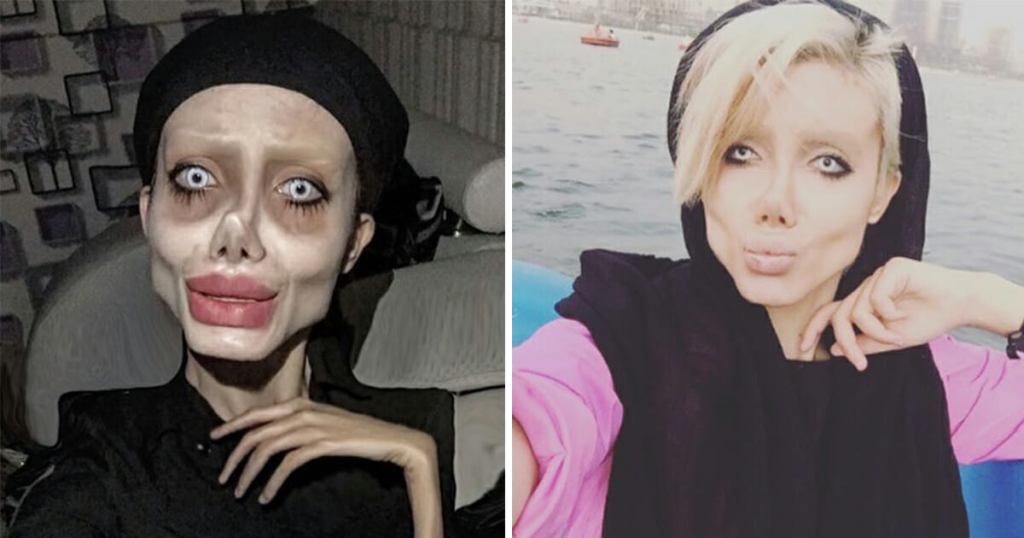Let’s be real — the internet loves a spectacle. And in 2017, that’s exactly what it got when photos of a mysterious, skeletal-looking young woman from Iran began flooding social media. Her name? Sahar Tabar. Or at least, that was the name she used online.
Dubbed the “Angelina Jolie lookalike,” Sahar’s haunting, heavily edited selfies sparked a media frenzy. But behind the filters and eerie makeup was a much deeper — and often misunderstood — story. This isn’t just about vanity or plastic surgery. It’s about fame, freedom, and the collision of personal expression with cultural and political boundaries.

Who Is Sahar Tabar?
Sahar Tabar is the Instagram alias of Fatemah Khishvand, a young woman from Tehran, Iran. Long before the world knew her name, she had a passion for creativity and self-expression. That passion took shape through extreme makeup, dramatic photo editing, and eventually, cosmetic procedures.
Her photos went viral for resembling a “zombie version” of Angelina Jolie. But Sahar later clarified that her goal wasn’t to mimic the actress. “I had no interest in looking like Angelina Jolie,” she said in a 2017 interview. “I am my own muse.”
Video: Who is Sahar Tabar? The shocking Angelina Jolie look alike – Weird Internet
The Transformation That Shook the Internet
What drew over 400,000 followers to Sahar’s Instagram profile wasn’t just curiosity — it was shock. Her skeletal features, oversized lips, and otherworldly appearance seemed too surreal to be real. And that’s because, in many cases, they weren’t.
Sahar later admitted that a large portion of her content was heavily photoshopped or enhanced with makeup tricks. Still, she did undergo real cosmetic procedures, including rhinoplasty, lip injections, and liposuction. Her dramatic look wasn’t just for fun — it was art, performance, and protest rolled into one.
Plastic Surgery and Pop Culture in Iran
To understand Sahar’s story, it helps to know a bit about the culture she comes from. Iran has one of the highest rates of plastic surgery in the world — especially nose jobs. Cosmetic enhancement is popular and often seen as a ticket to social capital and fame.
In this context, Sahar’s transformation wasn’t an anomaly — it was an exaggerated mirror of a culture obsessed with perfection. But she pushed the envelope way further than most dared.
Art or Attention? Sahar’s Perspective on Her Online Persona

From Sahar’s point of view, what she was doing was performance art. Her extreme images were a way of making people think — or at least talk. “It’s a form of self-expression,” she explained, noting that she enjoyed exploring identity through visual experimentation.
But her followers didn’t always get the message. To many, Sahar’s look was disturbing. Comments ranged from awe to harsh criticism, with many accusing her of “ruining” her face. Still, Sahar stayed the course. “For me, the most important thing is the acceptance of my family and God,” she once said. “That is enough for me.”
From Internet Fame to Imprisonment
Sahar’s fame took a dark turn in October 2019, when she was arrested by Iranian authorities. The charges? “Blasphemy,” “corruption,” and “encouraging youth to engage in moral deviancy.” Her Instagram account was shut down, and she was sentenced to 10 years in prison.
The global outcry was swift. Iranian human rights activists, including Masih Alinejad, called on celebrities like Angelina Jolie to speak out on Sahar’s behalf. “Her joke landed her in jail,” Alinejad tweeted. “Her mother cries every day to get her innocent daughter freed.”
Release and Redemption: The Turning Point
Video: Angelina Jolie ‘lookalike’ Sahar Tabar speaks out
In a surprising turn of events, Sahar was released after just 14 months. The timing coincided with widespread protests in Iran sparked by the death of Mahsa Amini, which brought global attention to issues of women’s rights and government repression.
Following her release, Sahar made a televised appearance, revealing her real face to the public for the first time in years. Gone was the haunting Corpse Bride look — in her place was a young woman with a soft voice and a surprisingly gentle demeanor. She admitted that many of her online photos were digitally manipulated, and reiterated that her intent was never to copy Angelina Jolie.
The Aftermath: A New Beginning or a Cautionary Tale?
As of now, Sahar’s original Instagram account remains deactivated, but fan pages and reposts keep her image alive online. She hasn’t resumed posting new content under her real name, perhaps signaling a more private chapter of her life.
Her story raises plenty of questions: When does self-expression cross a line? Who decides what’s acceptable when it comes to personal image? And what happens when internet fame collides with political power?
Sahar’s tale is part urban legend, part tragedy, and part warning. In a world where likes and followers can be a path to fame or prison, her story reminds us how thin the line between freedom and repression can be — especially for women in restrictive societies.
Conclusion: A Face, A Filter, and A Fight for Identity

Sahar Tabar’s story is not just about plastic surgery or a viral internet hoax. It’s a complex, deeply human narrative about identity, expression, and the price of chasing visibility in a world that doesn’t always tolerate deviation.
What started as an online experiment became a life-altering experience. Whether you see her as an artist, a provocateur, or simply a young woman lost in the noise of social media, there’s no denying her story leaves a mark.
It challenges us to ask: How far would you go to be seen — and what would it cost you?


